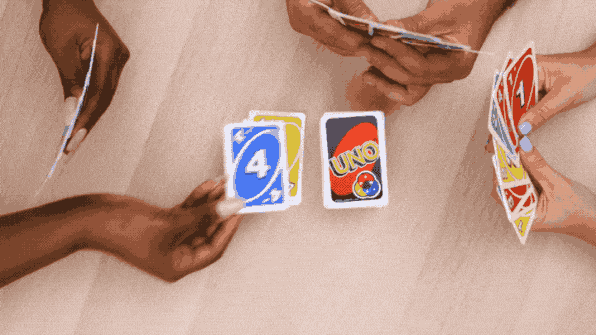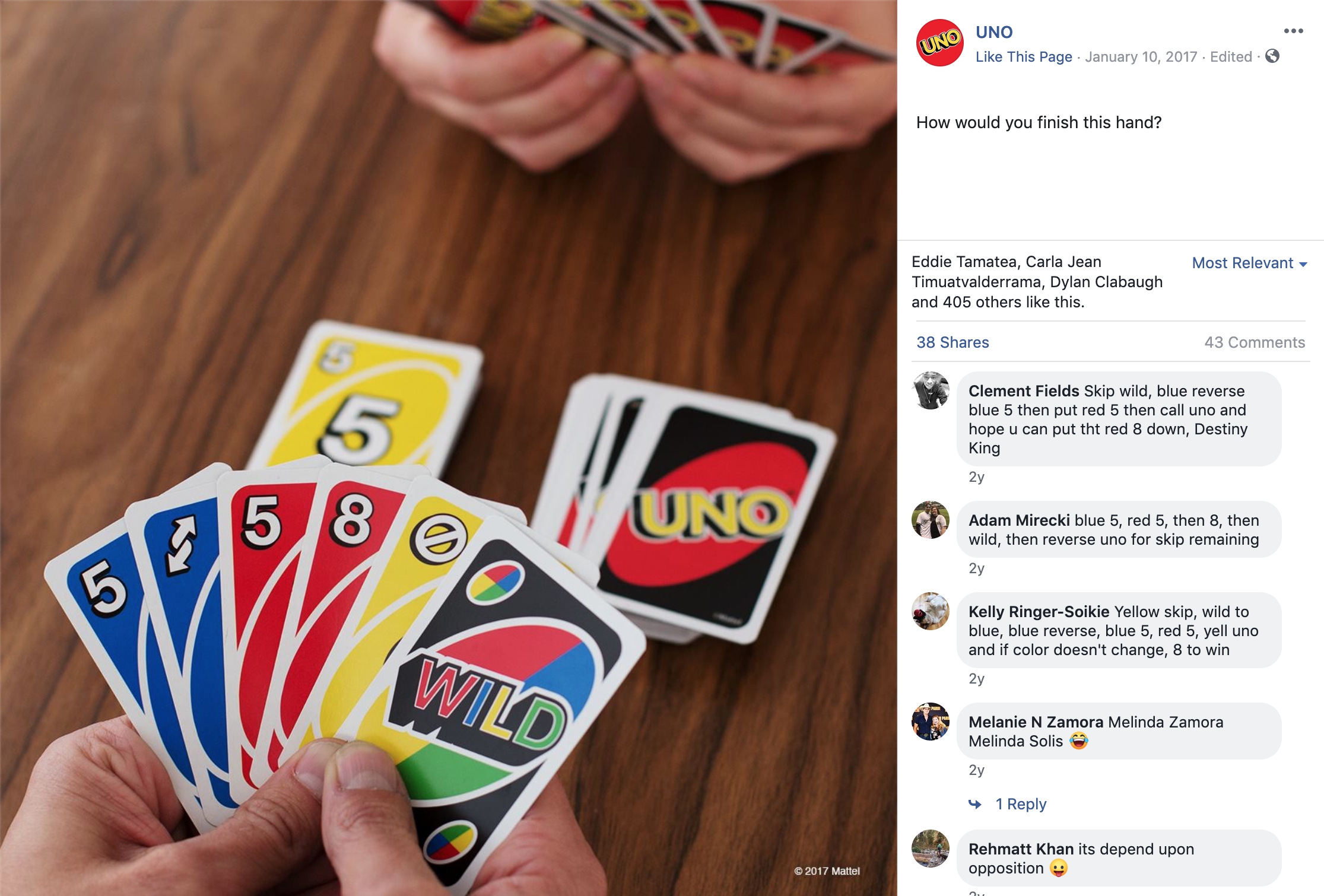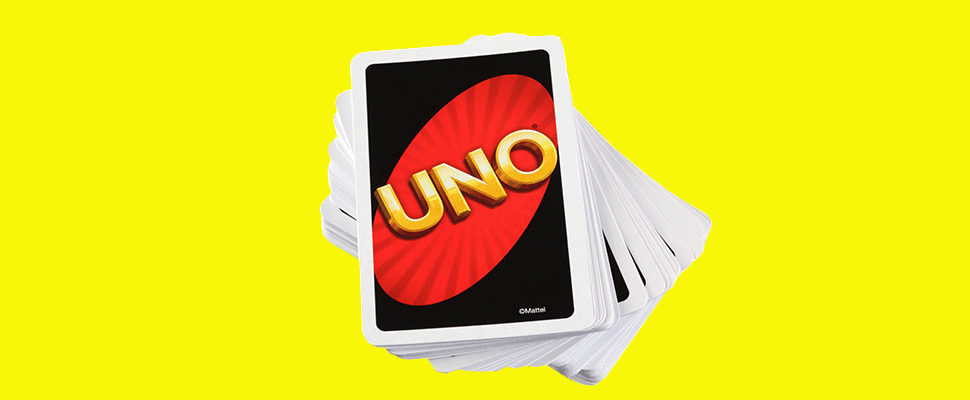
Have you played Uno recently? Like… more recently than when you were six? If so, you might just be ahead of the curve on a cultural phenomenon taking (back) over the country. That sounds insane, obviously, but it might not be — because Uno, the card game invented in 1971 and found in the junk drawer at every Grandma’s house, seems to be having a moment. People are playing and talking about the game more than ever. It’s kinda crazy.
The reasons for this resurgence offer a fascinating roadmap — not just for keeping card games fresh, but also for keeping companies relevant in the age of information. Here are the four secrets to Uno’s surge:
HOUSE RULES
In 2016, things get stale quickly. When played traditionally, Uno is low stakes and mostly luck based — sure to bore adults. But the game is thriving thanks to endlessly permutable house rules. The Atlanta Hawks basketball team likes to incorporate the “power cards” (+2, +4, Wild, Skip, Reverse) from a second deck into their game. Their big money Uno battles on the team plane were detailed on the front page of the New York Times sports section. The article told stories of bitter trash talk, huge wagers, and a hand when Kent Bazemore had to “draw 50.” Seems fun, right?
(Bazemore seems low key obsessed with Uno. It’s all over his Instagram and he put on a charity tournament over the summer.)
https://www.instagram.com/p/BOxy6A2gEBX/
Uno isn’t curmudgeonly about people changing the rules. In fact, they embrace it. The current deck comes with four blank wild cards, so that people can write in penalties or add new elements as they please (there is surely a “sex Uno” out there somewhere). This is open source gaming, analog style.
On January 2nd, with the news cycle at a dead standstill and the country on holiday, Uno shared the image above on their Facebook page. The house rule on the card reads, “Everyone must discard all their wild cards, except the holder of this card.” The post was shared 14,758 times.
For anyone who know’s Facebook and its algorithms, that’s an insane reach, bringing us to…
SOCIAL MEDIA SAVVY

The house rules post also had 5,400 comments. Monopoly has more than 10 million Facebook fans but nowhere near that level of engagement. Most of their posts only have a handful of comments. Uno’s Facebook page also offers up mock hands, as seen above, inviting fans to explain how they’d play out a given scenario. It sounds like something from the no-limit poker boom of the early 2000s (anyone remember the 2 + 2 forum?) … but remember we’re talking about Uno.
You know #FamilyGameNight just got real when you bring out @realUNOgame! Game on, fam. #Wild4UNO #ad pic.twitter.com/zY1TakCG2V
— Charles Tillman (@peanuttillman) December 18, 2016
That Twitter post is from ex-NFL star Charles Tillman. It’s also marked with #ad, which means somewhere, someone decided that retired Chicago Bear Charles Tillman was the perfect person to get paid to promote the Uno brand. That Mattel is using social media shout outs for marketing shows just how “of the times” the game is.
Even when it’s not part of a paid post, Uno is clever on Twitter, following a path set down by other brands that rely on high consumer awareness — Merriam Webster, for example.
This is for all those times you pretended to throw the ball during fetch. 🐶 #Wild4UNO pic.twitter.com/iWM5hHglEK
— UNO (@realUNOgame) October 19, 2016
Uno’s Twitter handle is also quick to retweet jokes made by people chattering about the game on social media, which works perfectly considering…
IT’S HIGHLY MEME-ABLE (AND CELEBRATES PETTINESS)
There is a whole corner of Instagram and Twitter that moves via memes and Uno is probably the most meme-able card game on earth. Why? Because it lets us revel in revenge (without, y’know, genuinely hurting anyone) and that’s a recipe for fun.
In fact, the Uno revolution has synched perfectly with social media’s love of pettiness, “clapping back,” and holding onto tiny grudges:
https://www.instagram.com/p/BJ9dvuXAcHH/?taken-by=danhechanova
https://twitter.com/MShrayber/status/815385267573923840
The best part is, if you look at the company’s social feeds, they’re very much in on the joke. They laugh when we make memes about sh*t getting real, they encourage our pettiness across all their platforms. And there are a lot of platforms because…
IT’S EVERYWHERE
https://twitter.com/MShrayber/status/815447924922384384
Uno has an app and a Facebook game. It’s on PS4 and XBox One. On January 4th, a new version of the game was released for PCs which allows you to import your house rules. They even make oversized, undersized, and waterproof cards.
In the fight over game night, the game that conquers is the game that comes to mind quickly. Because of its popularity on social media, iconic design, and the endless platforms it’s available on, Uno seems to be winning that war. It’s an old fashioned game that saw the direction culture was heading and has kept up — making it a fascinating case study and a hell of a lot of fun.
Now, what you’ve been waiting for without ever realizing it…

THE AUTHOR’S UNO “HOUSE RULES”
These rules come from one simple idea: games are most fun when it’s a 75-25 split between skill and luck. Old Uno is too luck heavy. There’s a lot more strategy here.
FIRST: Pirating a second deck, add four Skips, four Reverse cards, four +2s, four +4s, and four Wilds to the main deck. Also, using any spare cards lying around, overload your deck with a few matching non-face cards (like TONS of Blue 2s, for instance).
SECOND: Using the “draw your own rule” wilds, make a + card as big as you think is reasonable (+20?). My girlfriend and I have a +8. Also, we have a card with a bomb on it, seen above. More on that later.
- Power cards compound. Meaning that if I play a +2 and the next person plays a +2, the third person has to draw 4. If I play a +4 and the next person plays a +4 and the third person plays a +4 then the fourth person has to draw twelve. With extra +2s and +4s in the deck, this can go on for ages. This is how Bazemore ended up drawing 50.
- You can play out of turn on any exact match. That means you can play your Blue 2 on someone else’s Blue 2 even when it’s not your turn. In effect, this skips other players, because the order continues after your play. This is why I overload my deck with Blue 2s. The rule also applies to power cards. So you can play a +4 out of turn on someone else’s +4, thereby sticking the person after you with eight cards (unless they have a +4, etc.).
- You can play different colored cards with the same number or symbol if it’s your turn and the person after you hasn’t gone. Meaning: If I play a Blue 2, I can also lay down a Red 2, a Yellow 2, etc. until the person after me cuts in. One caveat here: You have to reach back to your hand to play cards. You can’t just lay down three cards at once. This can be potent in a deck with lots of +2s, because if you have a bunch in your hand (withholding power cards is a huge strategy) you can keep playing them on top of each other until the person behind you has the sense to draw.
- Draw until you can play. This is instead of Uno’s stated ruled of “draw one card and miss your turn.” We like it because you can end up drawing a ton of cards. If you have a color card and can play, you have to, but if you have power cards, you can hold them back.
- +4 on all mistakes, +7 on a missed “Uno!” Draw four for any misplay, draw seven if you missed calling “Uno!” and someone else beats you to it.
- The BOOM card is ultimate power. It let’s you assign a whole stack of cards-to-be-drawn, to whomever you want. So say there has been a run of +4s and by the time it gets to you, it’s +20. You can play the boom and assign those 20 cards to anyone. This is a wonderful chance to be supremely petty.






